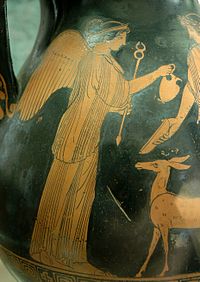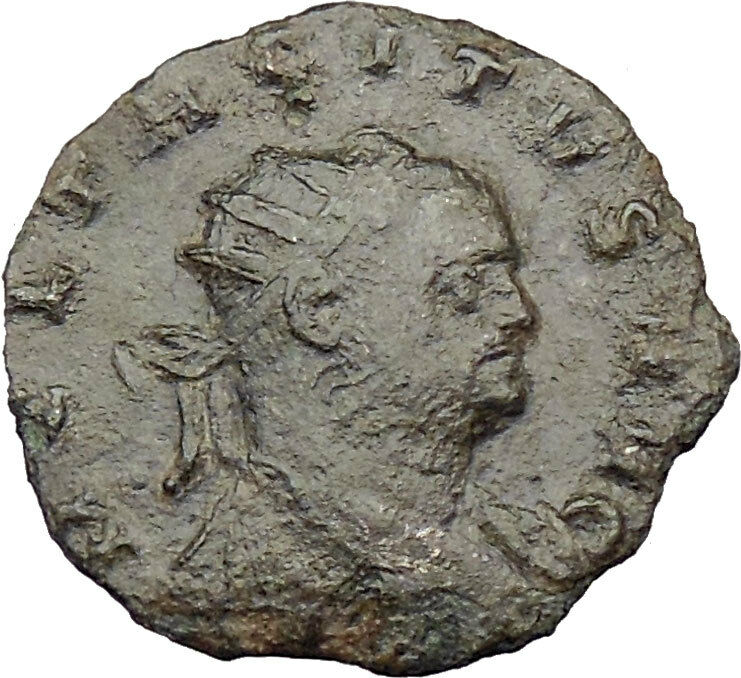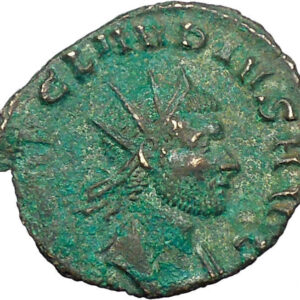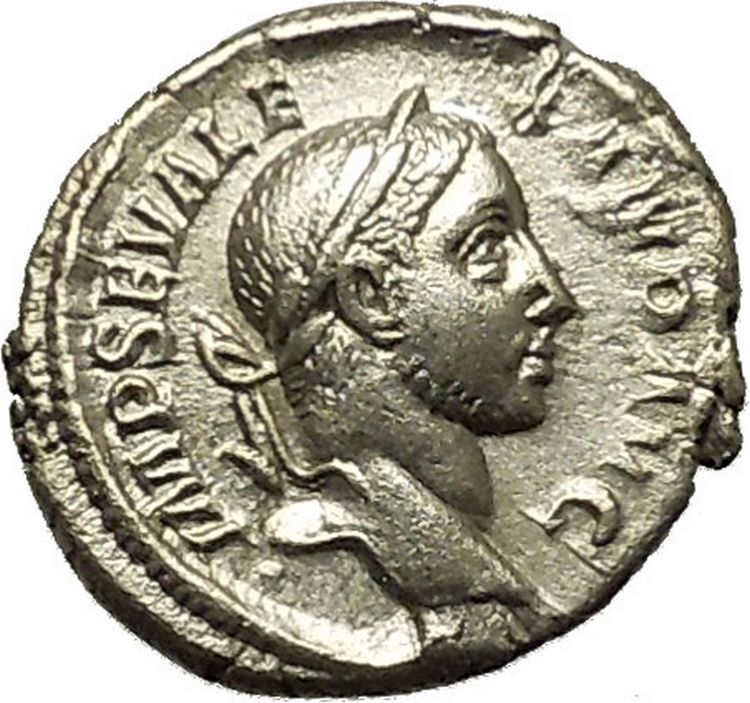|
Claudius II
Gothicus –
Roman Emperor
: 268-270 A.D.
Bronze Antoninianus 19mm (2.89 grams) Rome mint: 268-270 A.D.
Reference: RIC V-1 33.
IMP CLAVDIVS AVG, radiate head right
FELICITAS AVG, Felicitas standing left, holding caduceus and cornucopiae.
B in right field.
You are bidding on the exact item pictured,
provided with a Certificate of Authenticity and Lifetime Guarantee of
Authenticity.
The caduceus from
Greek
“herald’s staff” is the staff carried by
Hermes
in
Greek mythology
. The same staff was also borne
by heralds in general, for example by
Iris
, the messenger of
Hera. It is a short staff entwined by two
serpents
, sometimes surmounted by wings. In
Roman iconography it was often depicted being carried in the left hand of
Mercury
, the messenger of the gods, guide of
the dead and protector of merchants, shepherds, gamblers, liars, and thieves.
As a symbolic object it represents Hermes (or the Roman Mercury), and by
extension trades, occupations or undertakings associated with the god. In later
Antiquity
the caduceus provided the basis for
the
astrological symbol
representing the
planet Mercury
. Thus, through its use in
astrology
and
alchemy
, it has come to denote the
elemental metal
of the same name.
By extension of its association with Mercury/Hermes, the caduceus is also a
recognized symbol of commerce and negotiation, two realms in which balanced
exchange and reciprocity are recognized as ideals.[4][5]
This association is ancient, and consistent from the Classical period to modern
times. The caduceus is also used as a symbol representing printing, again by
extension of the attributes of Mercury (in this case associated with writing and
eloquence).
The caduceus is sometimes mistakenly used
as a symbol of medicine and/or medical practice
,
especially in
North America
, because of widespread confusion
with the traditional medical symbol, the
rod of Asclepius
, which has only a single snake
and no wings.
The term kerukeion denoted any herald’s staff, not necessarily
associated with Hermes in particular.[7]
Lewis Richard Farnell
(1909) in his study of
the cult of Hermes assumed that the two snakes had simply developed out of
ornaments of the shepherd’s crook used by heralds as their staff.[8]
This view has been rejected by later authors pointing to parallel iconography in
the Ancient Near East. It has been argued that the staff or wand entwined by two
snakes was itself representing a god in the pre-anthropomorphic era. Like the
herm
or
priapus
, it would thus be a predecessor of the
anthropomorphic Hermes of the classical era.
Ancient Near East
William Hayes Ward
(1910) discovered that
symbols similar to the classical caduceus sometimes appeared on
Mesopotamian cylinder seals
. He suggested the
symbol originated some time between 3000 and 4000 BCE, and that it might have
been the source of the Greek caduceus.[10]
A.L. Frothingham incorporated Dr. Ward’s research into his own work, published
in 1916, in which he suggested that the prototype of Hermes was an “Oriental
deity of Babylonian extraction” represented in his earliest form as a snake god.
From this perspective, the caduceus was originally representative of Hermes
himself, in his early form as the Underworld god
Ningishzida
, “messenger” of the “Earth Mother”.[11]
The caduceus is mentioned in passing by
Walter Burkert
[12]
as “really the image of copulating snakes taken over from Ancient Near Eastern
tradition”.
In Egyptian iconography, the
Djed pillar is depicted as containing a snake in a frieze of the
Dendera Temple complex
.
The rod of Moses
and the
brazen serpent
are frequently compared to the
caduceus, especially as Moses is acting as a messenger of God to the
Pharaoh
at the point in the narrative where he
changes his staff into a serpent.[13]
Classical antiquity
Mythology
The
Homeric hymn
to Hermes relates how Hermes
offered his lyre fashioned from a tortoise shell as compensation for the
cattle he stole
from his half brother
Apollo
. Apollo in return gave Hermes the
caduceus as a gesture of friendship.[14]
The association with the serpent thus connects Hermes to
Apollo
, as later the serpent was associated
with Asclepius
, the “son of Apollo”.[15]
The association of Apollo with the serpent is a continuation of the older
Indo-European
dragon
-slayer motif.
Wilhelm Heinrich Roscher
(1913) pointed out
that the serpent as an attribute of both Hermes and Asclepius is a variant of
the “pre-historic semi-chthonic serpent hero known at Delphi as
Python
“, who in classical mythology is slain by
Apollo.[16]
One Greek myth of origin
of the caduceus is part of the
story of Tiresias
,[17]
who found two snakes copulating and killed the female with his staff. Tiresias
was immediately turned into a woman, and so remained until he was able to repeat
the act with the male snake seven years later. This staff later came into the
possession of the god Hermes, along with its transformative powers.
Another myth suggests that Hermes (or Mercury) saw two serpents entwined in
mortal combat. Separating them with his wand he brought about peace between
them, and as a result the wand with two serpents came to be seen as a sign of
peace.[18]
In Rome, Livy
refers to the caduceator who
negotiated peace arrangements under the diplomatic protection of the caduceus he
carried.
Iconography
In some vase paintings ancient depictions of the Greek kerukeion are
somewhat different from the commonly seen modern representation. These
representations feature the two snakes atop the staff (or rod), crossed to
create a circle with the heads of the snakes resembling horns. This old graphic
form, with an additional crossbar to the staff, seems to have provided the basis
for the graphical
sign of Mercury
(☿) used in
Greek astrology
from Late Antiquity.[19]
Use in alchemy
and occultism
As the symbol of both the
planet
and the
metal
named for Mercury, the caduceus became an
important symbol in
alchemy
.
The
crucified serpent
was also revived as an
alchemical symbol for
fixatio
, and
John Donne
(Sermons 10:190) uses
“crucified Serpent” as a title of
Jesus Christ
.
Symbol of commerce
A simplified variant of the caduceus is to be found in dictionaries,
indicating a “commercial term” entirely in keeping with the association of
Hermes with commerce. In this form the staff is often depicted with two winglets
attached and the snakes are omitted (or reduced to a small ring in the middle).[20]
The Customs Service of the former
German Democratic Republic
employed the
caduceus, bringing its implied associations with thresholds, translators, and
commerce, in the service medals they issued their staff.
Misuse as symbol
of medicine
It is relatively common, especially in the United States, to find the
caduceus, with its two snakes and wings, used as a symbol of medicine instead of
the correct rod of Asclepius, with only a single snake. This usage is erroneous,
popularised largely as a result of the adoption of the caduceus as its insignia
by the
US Army medical corps
in 1902 at the insistence
of a single officer (though there are conflicting claims as to whether this was
Capt. Frederick P. Reynolds or Col. John R. van Hoff).[21][22]
The rod of Asclepius is the dominant symbol for professional healthcare
associations in the United States. One survey found that 62% of professional
healthcare associations used the rod of Asclepius as their symbol.[23]
The same survey found that 76% of commercial healthcare organizations used the
Caduceus symbol. The author of the study suggests the difference exists because
professional associations are more likely to have a real understanding of the
two symbols, whereas commercial organizations are more likely to be concerned
with the visual impact a symbol will have in selling their products.
The initial errors leading to its adoption and the continuing confusion it
generates are well known to medical historians. The long-standing and abundantly
attested historical associations of the caduceus with commerce, theft,
deception, and death are considered by many to be inappropriate in a symbol used
by those engaged in the healing arts.[22]
This has occasioned significant criticism of the use of the caduceus in a
medical context.
In
Roman mythology
, Felicitas (meaning “good luck” or “fortune”) was the
goddess or personification of good luck and success. The word felicitas, “luck”, is also the source of the word and name
felicity. She played an important
role in
Rome’s state religion
during the
empire
,
and was frequently portrayed on
coins
. She became a prominent symbol of the wealth and prosperity of the
Roman
Empire
.
Felicitas was unknown before the mid-2nd century BC, when a temple was
dedicated to her in the
Velabrum
in
the Campus Martius
by
Lucius Licinius Lucullus
, using booty from his 151–150 BC campaign in Spain.
The temple was destroyed by a fire during the reign of
Claudius
and was never rebuilt.
Another temple in Rome
was planned by
Julius Caesar
and was erected after his death by
Marcus Aemilius Lepidus
on the site of the
Curia Hostilia
, which had been restored by
Lucius Cornelius Sulla
but demolished by Caesar in 44 BC. This temple no
longer existed by the time of
Hadrian
, and
its site probably lies under the church of
Santi Martina e Luca
.
Marcus Aurelius Claudius (May
10, 213
– January, 270), often referred to as Claudius Gothicus or Claudius II,
was a Roman Emperor
. He ruled the
Roman
Empire
for less than two years (268 – 270), but during that brief time he
managed to obtain some successes. He was later given divine status.
//
Life
Origin
and rise to power
Claudius’ origin is uncertain. He was either from
Sirmium
(Syrmia;
in Pannonia
Inferior) or from Naissus
Dardania
(in
Moesia Superior
); both areas are located in
Serbia
.
Claudius was the commander of the Roman army that decisively defeated the
Goths
at the
Battle of Naissus
in September 268; in the same month, he attained the
throne, amid charges, never proven, that he murdered his predecessor
Gallienus
.
However, he soon proved to be less than bloodthirsty, as he asked the
Roman
Senate
to spare the lives of Gallienus’ family and supporters. He was less
magnanimous toward Rome’s enemies, however, and it was to this that he owed his
popularity.
Claudius, like
Maximinus Thrax
before him, was of barbarian birth. After an interlude of
failed aristocratic Roman emperors since Maximinus’s death, Claudius was the
first in a series of tough soldier-emperors who would eventually restore the
Empire from the
Crisis of the third century
.
Claudius
as emperor
At the time of his accession, the Roman Empire was in serious danger from
several incursions, both within and outside its borders. The most pressing of
these was an invasion of Illyricum and
Pannonia
by
the Goths
. Not
long after being named emperor (or just prior to Gallienus’ death, depending on
the source), he won his greatest victory, and one of the greatest in the history
of Roman arms.

The Roman Empire in 268 A.D
At the
Battle of Naissus
, Claudius and his legions routed a huge Gothic army.
Together with his cavalry commander, the future Emperor
Aurelian
,
the Romans took thousands of prisoners, destroyed the Gothic cavalry as a force
and stormed their laager (a circular alignment of wagons long favored by the
Goths). The victory earned Claudius his surname of “Gothicus” (conqueror of the
Goths), and that is how he is known to this day. More importantly, the Goths
were soon driven back across the
Danube River
, and a century passed before they again posed a serious threat
to the empire.
While this was going on, the Germanic tribe known as the
Alamanni
had crossed the Alps
and attacked the empire. Claudius responded quickly, routing the Alamanni at the
Battle of Lake Benacus
in the late fall of 268, a few months after the
battle of Naissus. He then turned on the
Gallic Empire
, ruled by a pretender for the past fifteen years and
encompassing
Britain
, Gaul
,
and the
Iberian Peninsula
. He won several victories and soon regained control of
Spain and the Rhone river valley of Gaul. This set the stage for the ultimate
destruction of the Gallic Empire under Aurelian.
However, Claudius did not live long enough to fulfill his goal of reuniting
all the lost territories of the empire. Late in 269 he was preparing to go to
war against the Vandals
, who were raiding in
Pannonia
.
However, he fell victim to the
Plague of Cyprian
(possibly
smallpox
),
and died early in January 270. Before his death, he is thought to have named
Aurelian as his successor, although Claudius’ brother
Quintillus
briefly seized power.
The Senate
immediately deified Claudius as “Divus Claudius Gothicus”.
Links
to
Constantinian dynasty
The
Historia Augusta
reports Claudius and Quintillus having another brother
named Crispus and through him a niece. Said niece Claudia reportedly married
Eutropius and was mother to
Constantius Chlorus
. Historians however suspect this account to be a
genealogical
fabrication intended to link
Constantine I
‘s family to that of a well-respected emperor.
|











